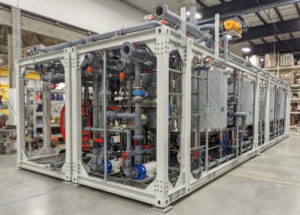
SaltMaker ChilledCrys Crystallizer
ChilledCrys is a novel and highly competitive alternative to expensive evaporators for zero liquid discharge of specific chemistries.
Apr 6th 2018
The SaltMaker MultiEffect evaporator crystallizer is a one-step brine treatment plant for volume minimization and zero liquid discharge (ZLD) applications. Its unique evaporative crystallizer design is built to treat the toughest waters and to simplify your brine treatment project.
The SaltMaker MultiEffect overcomes challenges that face conventional crystallizers:
The SaltMaker MultiEffect produces solids by circulating a brine slurry to continuously form and grow crystals. Salts preferentially grow on nucleation sites of suspended seed crystals rather than on heat transfer surfaces. The larger crystals settle and are discharged to a Solids Management System for automated bagging or binning. Concentrated liquor, including smaller salt seeds, is recycled back to the SaltMaker while solid salts remain behind in the bags or bins. The system notifies the operators when the bags are full and ready to be transported to a drainage rack by forklift.
The solids are then drained and pass the paint filter test, often within 24 hours of draining, after which the bag can be sent for disposal or re-use depending on the application. The Solids Management System takes the guess work out of management and improves reliability. The plant flushes and purges slurry lines to prevent clogging, discharges thick slurry to the bags only when necessary, and automatically recycles rich liquor brine and notifies operators when to change bags.
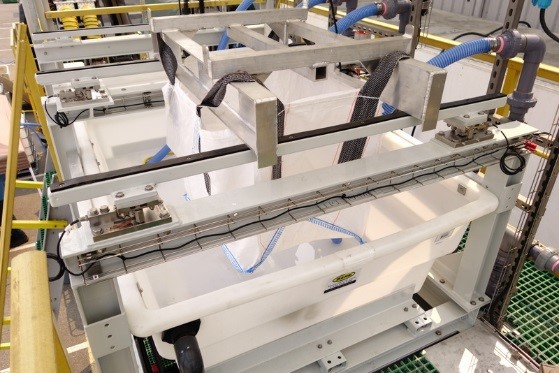
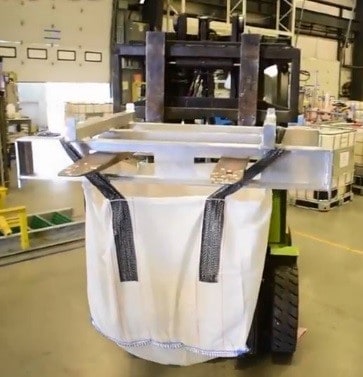

Traditional treatment technology requires multiple steps with different technologies to treat wastewater with high salinity levels. This includes separate systems for pre-treatment, evaporation, crystallization, solids production and dewatering. The SaltMaker combines these steps into a single system that requires no pre-treatment. It can be fed water at any salinity and almost any water chemistry. Expensive chemicals, such as soda ash, that increase solids load are avoided on the front end.
For ZLD applications, the Solids Management System can be added to the SaltMaker. Brine enters the plant, which produces freshwater and solids in bags or bins. No extra processing equipment, such as centrifuges or filter presses, is required. A simplified process flow diagram comparing the SaltMaker and a conventional process used to achieve ZLD is provided below.
The SaltMaker MultiEffect is predominantly built from plastics—namely gel-coated, fiber-reinforced plastics—with a low surface energy that provides resistance to corrosion and scale. The photos below showcase the different components of the SaltMaker.
The plant also operates with high circulation rates to provide scouring flows, and all wetted surfaces are exposed to continuous dynamic salinity gradients for salt saturation relief. Combined with sound engineering design, the SaltMaker prevents plugging and challenges in reliability that frequently affect conventional evaporators and crystallizers.
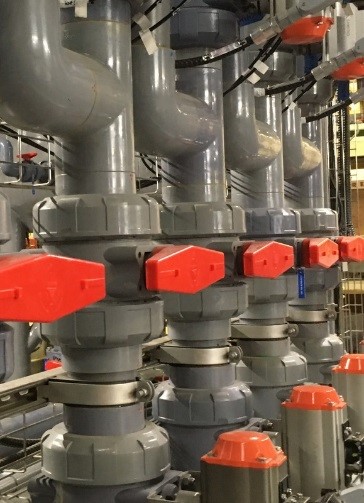
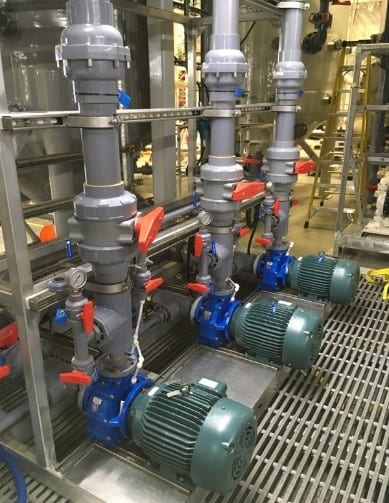
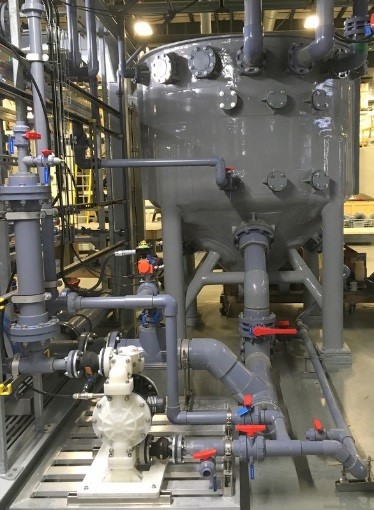
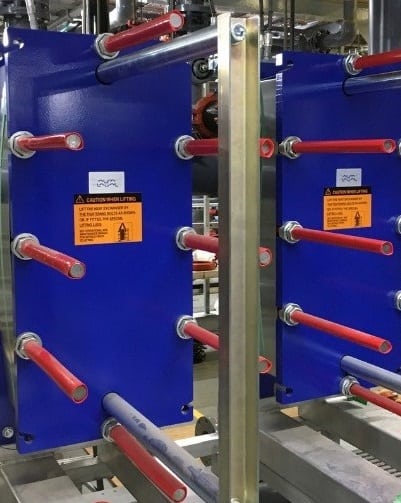
The SaltMaker MultiEffect has intelligent automated operations and self-cleaning processes. The plant can perform the following functions automatically: (1) start, (2) stop and flush, and (3) hibernate in circulation mode and ramp to 25% capacity in one step. Dynamic capacity control allows the SaltMaker to operate anywhere from 25% to 100% of rated capacity while being remotely managed via a secure internet connection.
The plant’s self-cleaning modes prevent irreversible scaling or fouling by regularly monitoring key performance metrics. It will then automatically trigger the appropriate level of cleaning, from ‘light rinse’ to ‘heavy scrub’. The SaltMaker uses distilled water as the cleaning fluid, which can be chemically augmented based on the type of scaling compounds and foulants in the brine. The wash solution is reused multiple times before being fed back to the SaltMaker for treatment once the fluid has been spent.
Unlike mechanical vapour recompression (MVR) technologies, where 100% of plant capacity is lost when the vapour compressor goes offline, the SaltMaker has no single point of failure. The plant is built with repeatable and redundant evaporation-condensation process sets. If a process set is down for maintenance, the plant continues to run at 92% capacity.



An Evaporation-Condensation process set: There are multiple process sets in an effect

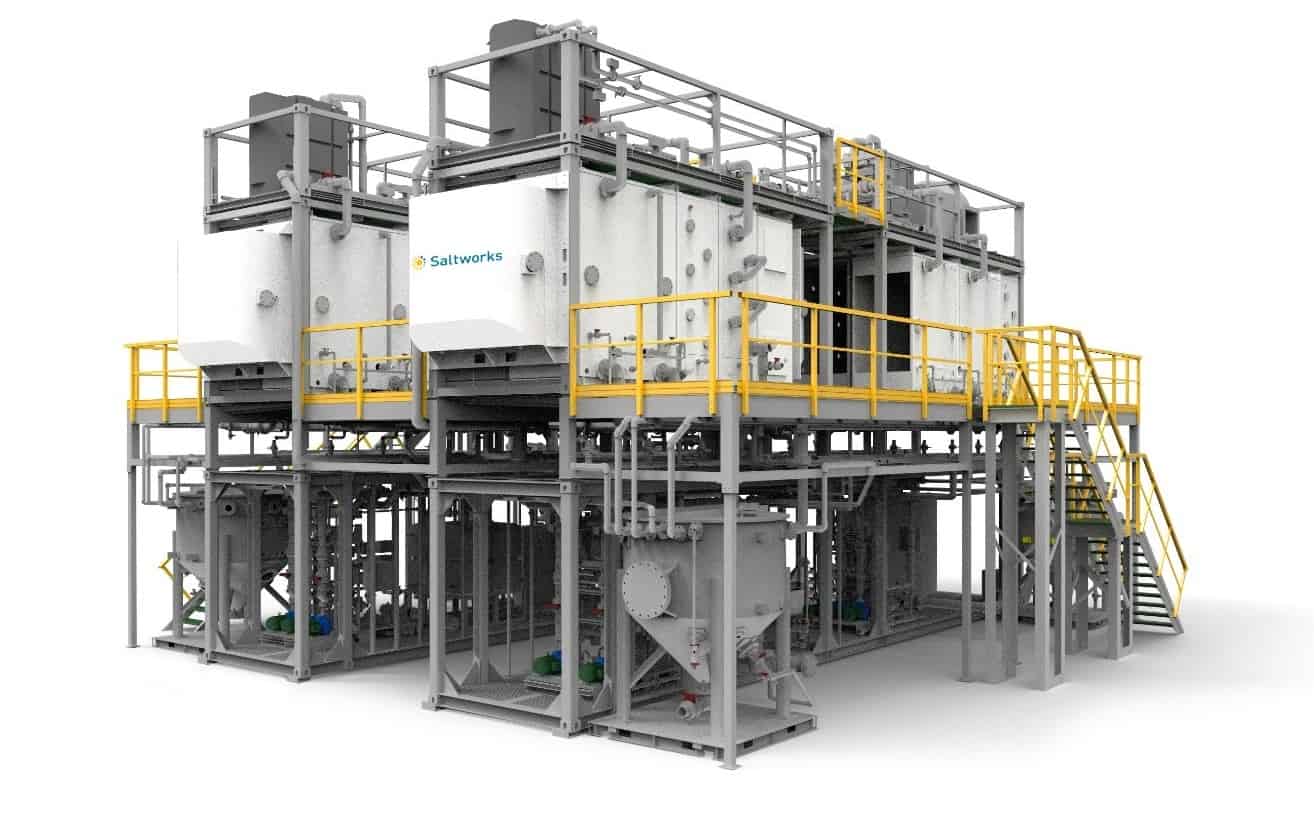
The SaltMaker MultiEffect is built into standard ISO container frames, which allow for ease of shipping, installation and future expansion. The open-concept design also allows for easy access to processing equipment, such as pumps, for inspection and routine maintenance, without the need for any confined space entry.


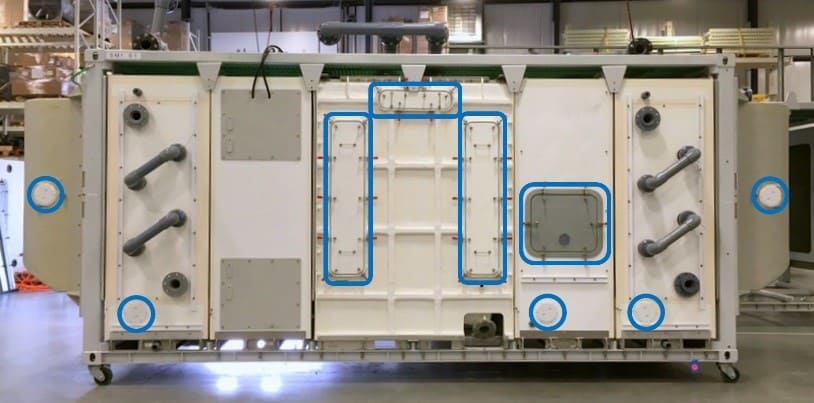
Multiple inspection ports (blue outlines in the photo above) in each effect allow for convenient monitoring of scaling and fouling. Process set modules slide in and out, and cleaning is done with a power washer.
The modular design simplifies transport and assembly. The SaltMaker is shipped by standard freight, without the need for any permits of oversized loads. The system is then assembled by crane onsite, as seen in the photos below.




SaltMaker MultiEffects are built to standardized plant sizes that can be added together to expand capacity as your project grows.
| Model | Capacity Based on Freshwater Removed* | |||
| m3/day | Gallons/day | Gallons/minute | Barrels/day | |
| S30 | 30 | 7900 | 5.5 | 188 |
| S66 | 66 | 17400 | 12 | 415 |
| S100 | 100 | 26400 | 18 | 630 |
| S125 | 125 | 33000 | 23 | 790 |
* Capacity derated by 20% to produce a 450,000 mg/L total solids slurry and by 40% to produce solids.


The SaltMaker MultiEffect is a multiple effect, thermally driven evaporator-crystallizer. It can use a variety of thermal sources: steam, low-grade waste heat, and gas or liquid fuel-fired low-pressure water heaters. It operates at atmospheric pressure and temperatures of less than 90oC, employing humidification-dehumidification air cycles that do not require a vacuum, pressure or boiling water on any heat transfer surfaces. Steam ticketed operators or pressure vessel certifications are not required.
In each of the effects, thermal energy is recycled, brine is concentrated, and freshwater is produced. Initial heat input to the plant at, for example, 92oC is used to evaporate and condense water in multiple effects, with the temperature being downgraded in each effect while the heat is recycled. This multiple effect process enables one unit of heat to produce four units of volume reduction, as shown the process diagram below.
Warm brine flows at high volumetric velocities through the system, and is sprayed into non-stick packing material of the evaporator modules. Approximately 1–2% of each droplet is evaporated to become freshwater vapour, while the droplet is concentrated and cooled. The droplet is pumped through the system again to recapture heat and further evaporate.
Air is the vapour carrier, with the fan module providing the motive force. Water vapour condenses into freshwater liquid at the radiator modules, which also transfers the latent heat of condensation to the next effect for energy efficiency. The final effect can be open or closed to atmosphere, providing cooling and heat rejection.
As water is evaporated, the brine is concentrated. Solid salts form on smaller salt seeds as saturation is exceeded. The smaller salt seeds are recycled from the Solids Management System (SMS) described above, with larger crystals forming and then discharging back to the SMS. This continuous cycling enables salt crystal growth and prevents the need for complex multi-step processes. The SMS is seamlessly integrated into the SaltMaker process, controls, and modular skids, so a single package can be delivered and operated.
Contact us to see how the SaltMaker MultiEffect fits into your project.
Saltworks Technologies is a leader in the development and delivery of solutions for industrial wastewater treatment and lithium refining. By working with customers to understand their unique challenges and focusing on continuous innovation, Saltworks’ solutions provide best-in-class performance and reliability. From its headquarters in Richmond, BC, Canada, Saltworks’ team designs, builds, and operates full-scale plants, and offers comprehensive onsite and offsite testing services with its fleet of mobile pilots.

ChilledCrys is a novel and highly competitive alternative to expensive evaporators for zero liquid discharge of specific chemistries.
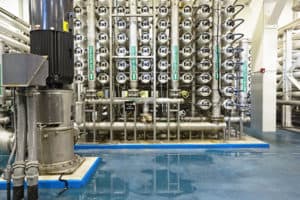
Saltworks is pleased to announce that recent advancements in reverse osmosis technology are now commercially available. Reduce conventional RO brine volumes by 50%, achieving brine concentrations of 130,000 to 150,000 mg/L TDS with spiral wound RO membranes.

Saltworks Technologies has been chosen to deliver two full-scale saline water treatment systems for a precious metals mine in the Canadian North. The zero liquid discharge (ZLD) plants will desalinate mine shaft water, and enable the site to achieve their treatment goals.

Zero liquid discharge (ZLD) is an engineering approach to water treatment where all water is recovered and contaminants are reduced to solid waste.